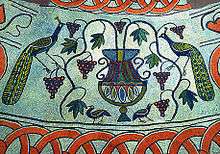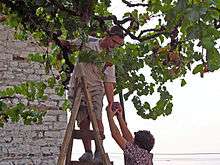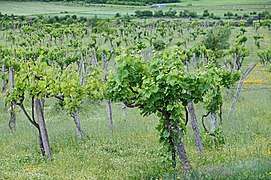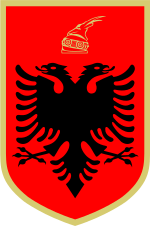Albanian wine
The Albanian wine (Albanian: Vera Shqiptare) is produced in several regions throughout Albania within the Mediterranean Basin. The country has one of the oldest wine making traditions, dating back to the ice and Bronze Age whereas Ancient Illyrians and Greeks inhabited the country's territory some 3,000 years ago. It belongs chronologically to the old world of wine producing countries.

Albania is a mountainous Mediterranean country and extend within the Mediterranean Basin with the Mediterranean Sea in the west. The country experiences a distinctly Mediterranean climate, which means that the winters are mild and summers usually hot and dry.[1] The favourable climate and fertile soil of the mountainous areas of the country are well suited to viticulture.
Albania produced an estimated 17,500 tonnes of wine in 2009.[2] During communism, the production area expanded to some 20,000 hectares (49,000 acres).[3]
History

The territory that is now Albania was one of few places where wine has naturally grown during the Ice Age. The oldest found seeds in the region are between 4,000 and 6,000 years old.[4]
Along with the neighbouring Greece, Albania has the longest continuous history of viticulture in Europe.[5][6][7][3] Within Illyria it existed hundreds of years before the expansion of the Roman Empire in the Balkan Peninsula.[8][9] The ancient Roman writer Pliny the Elder described Illyrian wine as being very sweet or luscious and refers to it as taking the third rank among all the wines.[10]
During the Roman period, wine production increased and became more organized. Decorations on numerous religious and household items bear witness to the wine-making culture such as in Butrint.[11] Although later in the 15th century, the Ottoman Turks arrived in Southeastern Europe. During that period the vineyards experienced a decline and were mostly found in Christian-majority regions.
After the Albanian Declaration of Independence, viticulture gained widespread popularity but was almost destroyed in 1933 by phylloxera. A significant upturn began only after the Second World War, at the end of which wine was still cultivated on only 2737 hectares. The most important producing region was around Durrës, where grapes were grown by communist state enterprises. In that time the nationwide acreage corresponded approximately to that of tobacco, but was significantly lower than that of olive and fruit trees. The exported wine was consumed primarily in Germany. The export decreased continuously from 61,000 hectoliters in 1971 to 22,000 hectoliters in 1985. The reasons are to be found mainly in outdated production conditions and insufficient technical material that made it difficult to transport and lowered the quality. On the other hand, the export of easily transportable raisins was continuously in increase (up to 3500 tons per year), while the export of fresh grapes was marginal. The most common varieties were Merlot, Cabernet Sauvignon, Pinot Noir, Sangiovese and Riesling.
Wine production in Communist Albania reached its peak in 1972. At this time there were 23 operating wineries and 47 grape production sites. They survived the transition to a market economy in good condition. Vineyards and wine production has been steadily increasing in recent years following the institution of democracy and capitalism.
Production
| 1950 | 1960 | 1970 | 1980 | 1990 | 2007 | 2009 | 2015 | |
|---|---|---|---|---|---|---|---|---|
| Vineyard area (ha) | 2,430 | 8,545 | 11,020 | 16,719 | 17,621 | 9,103 | 9,806 | 10,178 |
| Production (tonnes) | 21,400 | 22,300 | 64,500 | 66,200 | 91,000 | 146,500[lower-alpha 1] | 162,800 | 204,000 |
Wine regions

Albania can be separated into four wine regions, which are mainly defined by their altitude.[12][13][3] The regions includes the Coastal plains, Central hilly region, Eastern mountainous region and Mountain region. The highest vineyards sit at altitudes of approximately 1,000–1,300 metres (3,300–4,300 ft) in the slopes of the Albanian Alps in the north and Pindus Mountains in the southeast.
- The coastal plains (Western lowlands) rise to 300 m/990 ft and encompass the towns of Tiranë, Kavajë, Durrës, Shkodër, Lezhë, Lushnje, Fier, Vlorë, Pukë[14] and Delvinë.
- The central hilly region varies between 300 and 600 m/1,980 ft altitude and includes Elbasan, Krujë, Gramsh, Berat, Përmet, Librazhd and Mirditë.
- The Eastern sub-mountainous region lies between 600 and 800 m and surrounds the towns of Pogradec, Korçë, Leskovik and Peshkopi.
- Mountains (Highlands) vines are also grown as high as 1,000 m/3,300 ft. Soils are generally clay silica of varied depths and exposures.
Indigenous grape varieties

The main indigenous grape varieties found in Albania are: Shesh (black and white), Kallmet, Vlosh, Serinë, Pulës, Cërujë, Mereshnik, Debin (black and white), Kryqës, Mjaltëz, Mavrud, Manakuq, Kotekë, Vranac, Stambolleshë, Babasan, Tajgë (red and white), etc.
.jpg)
List of Wineries
Wineries (kantina in Albanian) in Albania include: Medaur,[15] Kallmeti,[16] Rilindja, Skënderbeu, Çobo,[17] Luani,[18] Bardha, Arbëri, Sara, Alimani, Vintage, Constantino Spanchis, Kardinal, Zika, Belba, Nurellari, Balaj, Koto, Vila Duka, Vila Shehi, Vila Hadaj, Belba, Enol, Korca 2000, and Kokomani.
Preferences
According to Nasse and Zigori (1968) the best native Albanian wine varieties are Debinë (noir and blanc), Kallmet, Mereshnik, Mjaltëz, Serinë (rouge and blanc), Shesh i Bardhë, and Vlosh.[19] The best wine-producing regions are Berat, Korçë, Tiranë, Durrës and the region between Lezhë and Shkodër.[20]
See also
| Wikimedia Commons has media related to Vineyards in Albania. |
- Cuisine of Albania
- Agriculture in Albania
- Old World wine
- Andrea Shundi
Notes
- Other sources put the figure at 105,000 tonnes (FAO: Agribusiness Handbook Grapes, Wine)
References
- Ministry of Environment of Albania. "Albania's Second National Communication to the Conference of Parties under the United Nations Framework Convention on Climate Change" (PDF). unfccc.int. Tirana. p. 28.
- "Wine production (tons)". Food and Agriculture Organization. p. 28. Archived from the original on 20 May 2011. Retrieved 2011-04-18.
- Matt Jensen (5 January 2018). "2018's Tour to the Albanian Wine and Uka Farm: Albanian Wine History". Nippy Wine.
- Tom Stevenson (2011). The Sotheby's Wine Encyclopedia. Dorling Kindersley. ISBN 978-1-4053-5979-5.
- PATTI MORROW (5 January 2017). "Why Albania Is A Great Destination For Wine Drinkers". epicureandculture.com.
- The Oxford Companion to Wine (Julia Harding, Jancis Robinson ed.). Oxford University Press, 2015. ISBN 9780198705383.
- The Sotheby’s Wine Encyclopedia (Tom Stevenson ed.). London: Dorling Kindersley. 2005. ISBN 0-7566-1324-8.
- "Albania - The Ancient Illyrians". thoughtco.com.
- "Hybrid Deities in South Dalmatia" (PDF). bollettinodiarcheologiaonline.beniculturali.it. p. 7. Archived from the original (PDF) on 2016-05-28. Retrieved 2017-12-20.
- The Laws of Fermentation and the Wines of the Ancients. Bronson Press. p. 41. Retrieved 2011-04-10.
- Oliver Gilkes and Valbona Hysa. "In the Shadow of Butrint" (PDF). penn.museum. p. 3.
- Oxford Companion to Wine (Jancis Robinson ed.). Oxford: Oxford University Press. 2015. p. 10. ISBN 9780198705383.
- Petraq Ilollari (Sotiri) (2010). Vitis Vinifera në vendin tonë/Vitis Vinifera in Our Country. pp. 8–13.
- "STUDIM ZHVILLIMI RURAL NE RRETHIN E PUKES" (PDF). anttarc.org (in Albanian). p. 19.
- Medaur
- Kallmeti
- Çobo
- Luani
- "The technology of wine making". Avi Pub. Co. p. 42. Retrieved 2011-04-10.
- Albania. Bradt. p. 42. Retrieved 2011-04-10.
Further reading
- Rutherford, Tristan (12 November 2017). "Albania's wine renaissance". The Guardian.
- Masotti, Francesca. "A Wine Lover's Guide to Albania". CultureTrip.
- Taylor, Alice. "Some Of Albania's BEST Wine". The Balkanista.
- Morrow, Pati. "Why Albania Is A Great Destination For Wine Drinkers". Epicure and Culture.

